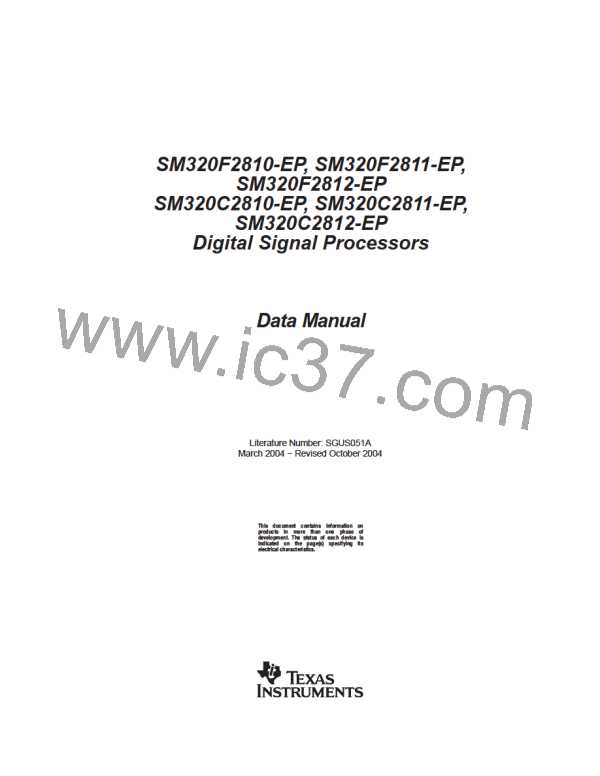Functional Overview
PF2:
SYS:
GPIO:
EV:
System Control Registers
GPIO Mux Configuration and Control Registers
Event Manager (EVA/EVB) Control Registers
McBSP: McBSP Control and TX/RX Registers
SCI:
SPI:
ADC:
Serial Communications Interface (SCI) Control and RX/TX Registers
Serial Peripheral Interface (SPI) Control and RX/TX Registers
12-Bit ADC Registers
3.2.19 General-Purpose Input/Output (GPIO) Multiplexer
Most of the peripheral signals are multiplexed with general-purpose I/O (GPIO) signals. This enables the user
to use a pin as GPIO if the peripheral signal or function is not used. On reset, all GPIO pins are configured
as inputs. The user can then individually program each pin for GPIO mode or Peripheral Signal mode. For
specific inputs, the user can also select the number of input qualification cycles. This is to filter unwanted noise
glitches.
3.2.20 32-Bit CPU-Timers (0, 1, 2)
CPU-Timers 0, 1, and 2 are identical 32-bit timers with presettable periods and with 16-bit clock prescaling.
The timers have a 32-bit count down register, which generates an interrupt when the counter reaches zero.
The counter is decremented at the CPU clock speed divided by the prescale value setting. When the counter
reaches zero, it is automatically reloaded with a 32-bit period value. CPU-Timer 2 is reserved for Real-Time
OS (RTOS)/BIOS applications. CPU-Timer 1 is also reserved for TI system functions. CPU-Timer 2 is
connected to INT14 of the CPU. CPU-Timer 1 can be connected to INT13 of the CPU. CPU-Timer 0 is for
general use and is connected to the PIE block.
3.2.21 Control Peripherals
The F281x and C281x support the following peripherals which are used for embedded control and
communication:
EV:
The event manager module includes general-purpose timers, full-compare/PWM units,
capture inputs (CAP) and quadrature-encoder pulse (QEP) circuits. Two such event
managers are provided which enable two three-phase motors to be driven or four
two-phase motors. The event managers on the F281x and C281x are compatible to the
event managers on the 240x devices (with some minor enhancements).
ADC:
The ADC block is a 12-bit converter, single ended, 16-channels. It contains two
sample-and-hold units for simultaneous sampling.
3.2.22 Serial Port Peripherals
The F281x and C281x support the following serial communication peripherals:
eCAN:
This is the enhanced version of the CAN peripheral. It supports 32 mailboxes, time stamping
of messages, and is CAN 2.0B-compliant.
McBSP:
This is the multichannel buffered serial port that is used to connect to E1/T1 lines,
phone-quality codecs for modem applications or high-quality stereo-quality Audio DAC
devices. The McBSP receive and transmit registers are supported by a 16-level FIFO. This
significantly reduces the overhead for servicing this peripheral.
37
March 2004 − Revised October 2004
SGUS051A

 TI [ TEXAS INSTRUMENTS ]
TI [ TEXAS INSTRUMENTS ]